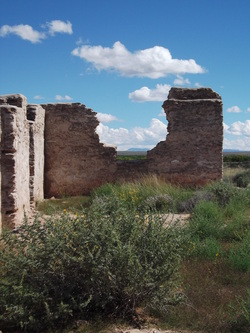
Time and disuse had ravaged both places, reducing them to fragments of shattered walls and long, low mounds that had once been ramparts. The adobe walls had melted back into the desert soils from which they had been formed.
We visited the one on a Thursday and the other on a Friday, and each time we had the run of the place to ourselves. The only sounds were the whistling of the wind over the broken stones, the chirp of crickets and the crunch of gravel beneath our feet. It was hard to believe that both sites had once bustled with life.
But it had been. I know this because I'd just recently finished reading Hampton Sides' Blood and Thunder, a biography of Kit Carson. One chapter told about Carson's time at Fort Craig, when he was serving as a Colonel in the First New Mexico Volunteer Infantry Regiment during the Civil War. Carson led his men against Confederate troops in the Battle of Valverde, which was fought just north of the fort. Sides includes in his narrative the tramp of drilling men, the neighing of horses, the cacaphony of parade bands, the thunder of artillery and the crackle of small arms. Mr. Sides breathed life into the scene. He made the Old West come alive again in my imagination.
As I stood among the dry and silent ruins, I remembered Sides' vivid descriptions. I considered how the parade grounds would have looked when the marching boots of seventeen companies of men kept the weeds at bay, how the air would have smelled when filled with the tang of horse dung and kitchen smoke and gunpowder.
Good history and good historical ficiton can breath life into events long past. It can resurrect people long dead and places that have mouIdered into dust. It can make that which has faded away become vivid again.
I don't know how much will be left of the old western forts in another decade or two. Perhaps there will be nothing for my grandchildren to see when they are old enough to care about what happened in New Mexico in the nineteenth century. But my hope is that those who follow will be able to resurrect the forts and the people who occupied them through the power of the written word.





